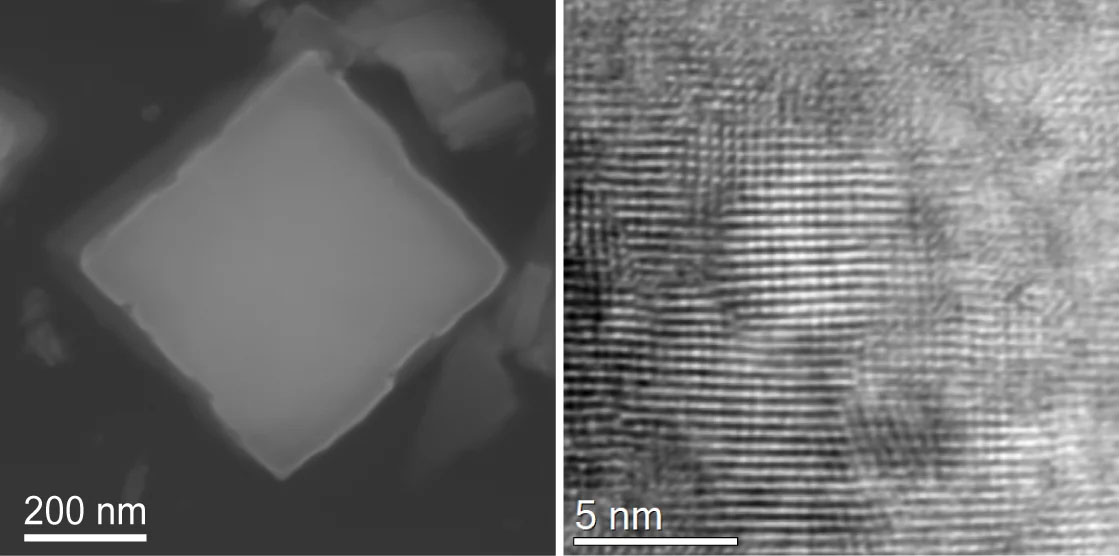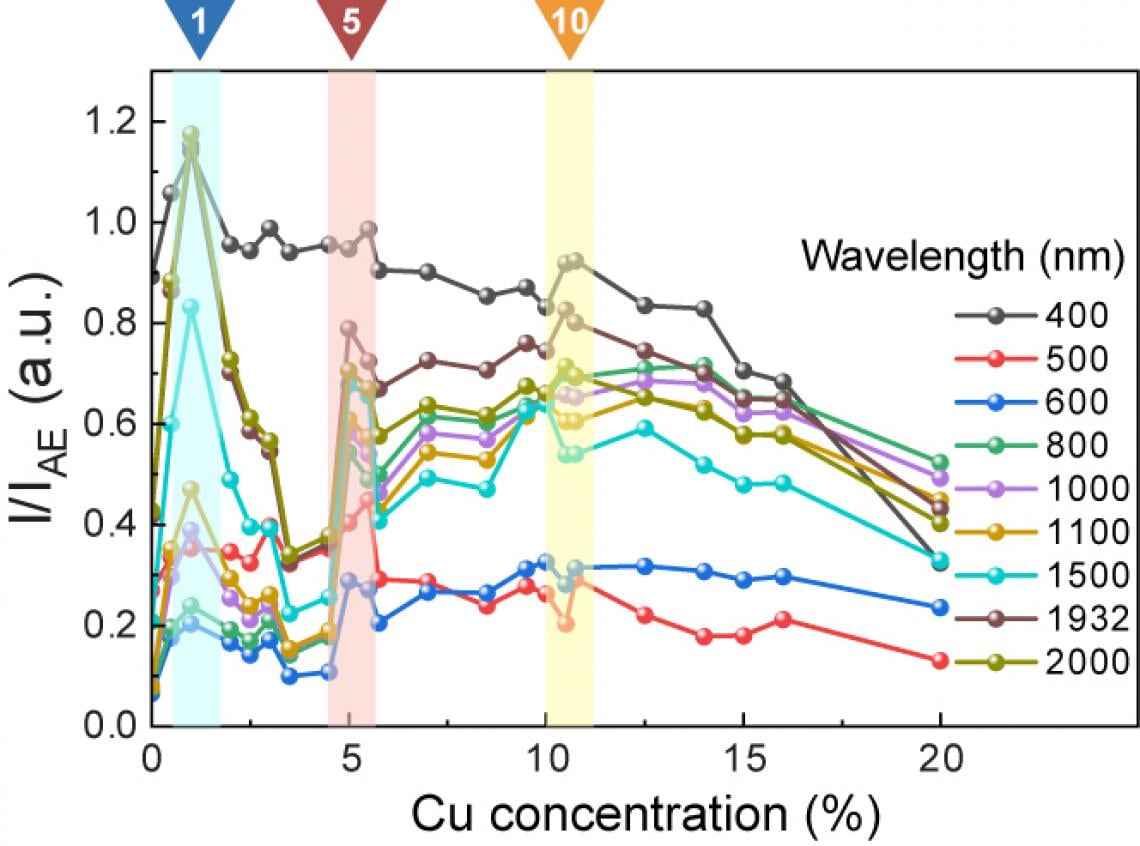Sep 13, 2023
(Nanowerk News) Sunlight is an inexhaustible source of energy, and utilizing sunlight to generate electricity is one of the cornerstones of renewable energy. More than 40% of the sunlight that falls on earth is in the infrared, visible and ultraviolet spectra; however, current solar technology utilizes primarily visible and ultraviolet rays. Technology to utilize the full spectrum of solar radiation—called all-solar utilization—is still in its infancy.
A team of researchers from Hokkaido University, led by Assistant Professor Melbert Jeem and Professor Seiichi Watanabe at the Faculty of Engineering, have synthesized tungstic acid-based materials doped with copper that exhibited all-solar utilization.
 (Left) A single copper-doped tungstic acid nanocrystal; (right) Atomic resolution image of the nanocrystal. (Image: Melbert Jeem)
Their findings were published in the journal Advanced Materials ("Defect driven opto-critical phases tuned for all-solar utilization").
“Currently, the near- and mid-infrared spectra of solar radiation, ranging from 800 nm to 2500 nm, is not utilized for energy generation,” explains Jeem. “Tungstic acid is a candidate for developing nanomaterials that can potentially utilize this spectrum, as it possesses a crystal structure with defects that absorb these wavelengths.”
The team used a photo-fabrication technique they had previously developed, submerged photo-synthesis of crystallites, to synthesize tungstic acid nanocrystals doped with varying concentrations of copper. The structures and light-absorbing properties of these nanocrystals were analyzed; their photothermal, photo-assisted water evaporation, and photo-electrochemical characteristics were measured.
(Left) A single copper-doped tungstic acid nanocrystal; (right) Atomic resolution image of the nanocrystal. (Image: Melbert Jeem)
Their findings were published in the journal Advanced Materials ("Defect driven opto-critical phases tuned for all-solar utilization").
“Currently, the near- and mid-infrared spectra of solar radiation, ranging from 800 nm to 2500 nm, is not utilized for energy generation,” explains Jeem. “Tungstic acid is a candidate for developing nanomaterials that can potentially utilize this spectrum, as it possesses a crystal structure with defects that absorb these wavelengths.”
The team used a photo-fabrication technique they had previously developed, submerged photo-synthesis of crystallites, to synthesize tungstic acid nanocrystals doped with varying concentrations of copper. The structures and light-absorbing properties of these nanocrystals were analyzed; their photothermal, photo-assisted water evaporation, and photo-electrochemical characteristics were measured.
 A summarized relative light absorption of the tungstic acid crystals ranging from ultraviolet to infrared light. 1, 5, and 10 are the copper concentrations resulting in opto-criticality of the nanocrystals. (© Melbert Jeem, et al. Advanced Materials)
The copper-doped tungsten oxide nanocrystals absorb light across the spectrum, from ultraviolet through visible light to infrared; the amount of infrared light absorbed was greatest at 1% copper doping. 1% and 5% copper-doped nanocrystals exhibited the highest temperature elevation (photothermal characteristic); 1% copper doped crystals also exhibited the greatest water evaporation efficacy, at approximately 1.0 kg per m2 per hour. Structural analysis of the 1% copper-doped nanocrystals indicated that the copper ions may be distorting the crystal structure of tungsten oxide, leading to the observed characteristics when light is absorbed.
“Our discoveries mark a significant advance in advancement in the design of nanocrystallites capable of both synthesizing and harnessing all-solar energy,” concludes Watanabe. “We have demonstrated that copper doping grants tungstic acid nanocrystal a variety of characteristics via all-solar utilization. This provides a framework for further research in the field as well as for the development of applications.”
A summarized relative light absorption of the tungstic acid crystals ranging from ultraviolet to infrared light. 1, 5, and 10 are the copper concentrations resulting in opto-criticality of the nanocrystals. (© Melbert Jeem, et al. Advanced Materials)
The copper-doped tungsten oxide nanocrystals absorb light across the spectrum, from ultraviolet through visible light to infrared; the amount of infrared light absorbed was greatest at 1% copper doping. 1% and 5% copper-doped nanocrystals exhibited the highest temperature elevation (photothermal characteristic); 1% copper doped crystals also exhibited the greatest water evaporation efficacy, at approximately 1.0 kg per m2 per hour. Structural analysis of the 1% copper-doped nanocrystals indicated that the copper ions may be distorting the crystal structure of tungsten oxide, leading to the observed characteristics when light is absorbed.
“Our discoveries mark a significant advance in advancement in the design of nanocrystallites capable of both synthesizing and harnessing all-solar energy,” concludes Watanabe. “We have demonstrated that copper doping grants tungstic acid nanocrystal a variety of characteristics via all-solar utilization. This provides a framework for further research in the field as well as for the development of applications.”
 (Left) A single copper-doped tungstic acid nanocrystal; (right) Atomic resolution image of the nanocrystal. (Image: Melbert Jeem)
Their findings were published in the journal Advanced Materials ("Defect driven opto-critical phases tuned for all-solar utilization").
“Currently, the near- and mid-infrared spectra of solar radiation, ranging from 800 nm to 2500 nm, is not utilized for energy generation,” explains Jeem. “Tungstic acid is a candidate for developing nanomaterials that can potentially utilize this spectrum, as it possesses a crystal structure with defects that absorb these wavelengths.”
The team used a photo-fabrication technique they had previously developed, submerged photo-synthesis of crystallites, to synthesize tungstic acid nanocrystals doped with varying concentrations of copper. The structures and light-absorbing properties of these nanocrystals were analyzed; their photothermal, photo-assisted water evaporation, and photo-electrochemical characteristics were measured.
(Left) A single copper-doped tungstic acid nanocrystal; (right) Atomic resolution image of the nanocrystal. (Image: Melbert Jeem)
Their findings were published in the journal Advanced Materials ("Defect driven opto-critical phases tuned for all-solar utilization").
“Currently, the near- and mid-infrared spectra of solar radiation, ranging from 800 nm to 2500 nm, is not utilized for energy generation,” explains Jeem. “Tungstic acid is a candidate for developing nanomaterials that can potentially utilize this spectrum, as it possesses a crystal structure with defects that absorb these wavelengths.”
The team used a photo-fabrication technique they had previously developed, submerged photo-synthesis of crystallites, to synthesize tungstic acid nanocrystals doped with varying concentrations of copper. The structures and light-absorbing properties of these nanocrystals were analyzed; their photothermal, photo-assisted water evaporation, and photo-electrochemical characteristics were measured.
 A summarized relative light absorption of the tungstic acid crystals ranging from ultraviolet to infrared light. 1, 5, and 10 are the copper concentrations resulting in opto-criticality of the nanocrystals. (© Melbert Jeem, et al. Advanced Materials)
The copper-doped tungsten oxide nanocrystals absorb light across the spectrum, from ultraviolet through visible light to infrared; the amount of infrared light absorbed was greatest at 1% copper doping. 1% and 5% copper-doped nanocrystals exhibited the highest temperature elevation (photothermal characteristic); 1% copper doped crystals also exhibited the greatest water evaporation efficacy, at approximately 1.0 kg per m2 per hour. Structural analysis of the 1% copper-doped nanocrystals indicated that the copper ions may be distorting the crystal structure of tungsten oxide, leading to the observed characteristics when light is absorbed.
“Our discoveries mark a significant advance in advancement in the design of nanocrystallites capable of both synthesizing and harnessing all-solar energy,” concludes Watanabe. “We have demonstrated that copper doping grants tungstic acid nanocrystal a variety of characteristics via all-solar utilization. This provides a framework for further research in the field as well as for the development of applications.”
A summarized relative light absorption of the tungstic acid crystals ranging from ultraviolet to infrared light. 1, 5, and 10 are the copper concentrations resulting in opto-criticality of the nanocrystals. (© Melbert Jeem, et al. Advanced Materials)
The copper-doped tungsten oxide nanocrystals absorb light across the spectrum, from ultraviolet through visible light to infrared; the amount of infrared light absorbed was greatest at 1% copper doping. 1% and 5% copper-doped nanocrystals exhibited the highest temperature elevation (photothermal characteristic); 1% copper doped crystals also exhibited the greatest water evaporation efficacy, at approximately 1.0 kg per m2 per hour. Structural analysis of the 1% copper-doped nanocrystals indicated that the copper ions may be distorting the crystal structure of tungsten oxide, leading to the observed characteristics when light is absorbed.
“Our discoveries mark a significant advance in advancement in the design of nanocrystallites capable of both synthesizing and harnessing all-solar energy,” concludes Watanabe. “We have demonstrated that copper doping grants tungstic acid nanocrystal a variety of characteristics via all-solar utilization. This provides a framework for further research in the field as well as for the development of applications.”
Source: Hokkaido University (Note: Content may be edited for style and length)
We curated lists with the (what we think) best science and technology podcasts - check them out!
Nanowerk Newsletter
Get our daily Nanotechnology News to your inbox!

